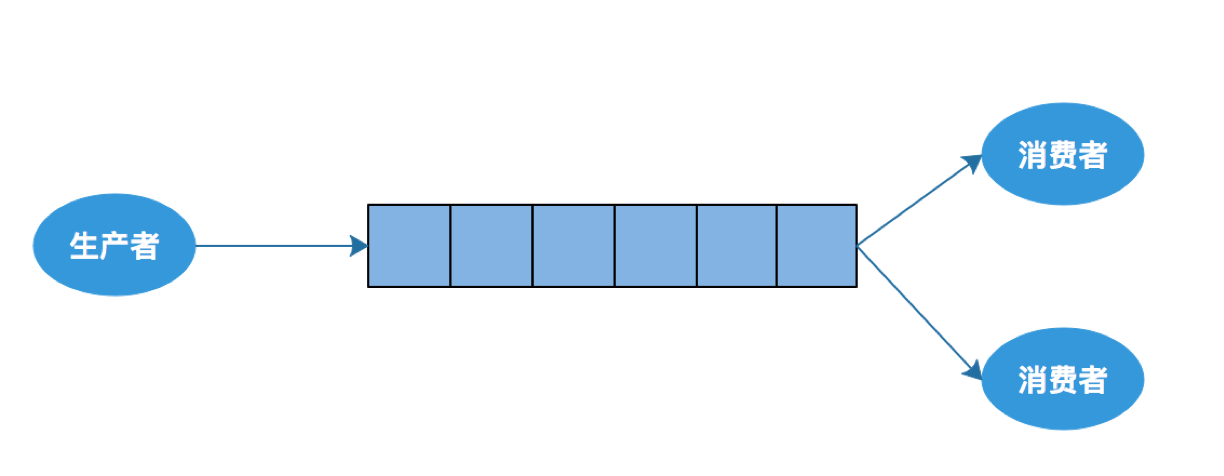一、交换器
rabbitmq有四种交换器,分别如下:
1、direct:如果路由键完全匹配的话,消息才会被投放到相应的队列。
2、fanout:当发送一条消息到fanout交换器上时,它会把消息投放到所有附加在此交换器上的队列。
3、topic:设置模糊的绑定方式,“*”操作符将“.”视为分隔符,匹配单个字符;“#”操作符没有分块的概念,它将任意“.”均视为关键字的匹配部分,能够匹配多个字符。
4、header:根据发送的消息内容中的headers属性进行匹配
二、队列
1、简单队列:一个消费者一个生产者

生产者
# !/usr/bin/env python # -*- coding: utf-8 -*- import pika host = "10.31.4.96" port = 5672 user = "root" passwd = "12345678" virtual_host = "/" credentials = pika.PlainCredentials(user,passwd) # 认证凭证 connection = pika.BlockingConnection(pika.ConnectionParameters(host=host,port=port,virtual_host=virtual_host,credentials=credentials)) # 建立连接 channel = connection.channel(channel_number=2) # 创建信道 channel.queue_declare(queue='hello') # 创建队列 channel.basic_publish(exchange='',routing_key='hello',body='Hello World!') # 使用默认的交换器,exchange设置为空,routing_key设置队列名称 print(" [x] Sent 'Hello World!'") connection.close()
消费者
# !/usr/bin/env python # -*- coding: utf-8 -*- import pika, sys, os host = "10.31.4.96" port = 5672 user = "root" passwd = "12345678" virtual_host = "/" def main(): credentials = pika.PlainCredentials(user, passwd) # 认证凭证 connection = pika.BlockingConnection(pika.ConnectionParameters(host=host, port=port, virtual_host=virtual_host, credentials=credentials)) # 建立连接 channel = connection.channel(channel_number=2) # 创建信道 channel.queue_declare(queue='hello') # 创建队列 def callback(ch, method, properties, body): print(" [x] Received %r" % body) channel.basic_consume(queue='hello', on_message_callback=callback, auto_ack=True) print(' [*] Waiting for messages. To exit press CTRL+C') channel.start_consuming() if __name__ == '__main__': try: main() except KeyboardInterrupt: print('Interrupted') try: sys.exit(0) except SystemExit: os._exit(0)
2、work模式:一个生产者对应多个消费者,但是只能有一个消费者获得消息

# !/usr/bin/env python # -*- coding: utf-8 -*- import pika,sys host = "10.31.4.96" port = 5672 user = "root" passwd = "12345678" virtual_host = "/" credentials = pika.PlainCredentials(user,passwd) # 认证凭证 connection = pika.BlockingConnection(pika.ConnectionParameters(host=host,port=port,virtual_host=virtual_host,credentials=credentials)) # 建立连接 channel = connection.channel() # 创建信道 channel.queue_declare(queue='hello',durable=True) # 创建队列,durable=True持久化队列 message = ' '.join(sys.argv[1:]) or "Hello World!" channel.basic_publish(exchange='', routing_key='hello', body=message, properties=pika.BasicProperties( delivery_mode = 2, # 消息持久化 ) ) print(" [x] Sent %r" % message)
消费者
# !/usr/bin/env python # -*- coding: utf-8 -*- import pika, sys, os,time host = "10.31.4.96" port = 5672 user = "root" passwd = "12345678" virtual_host = "/" def main(): credentials = pika.PlainCredentials(user, passwd) # 认证凭证 connection = pika.BlockingConnection(pika.ConnectionParameters(host=host, port=port, virtual_host=virtual_host, credentials=credentials)) # 建立连接 channel = connection.channel() # 创建信道 channel.queue_declare(queue='hello',durable=True) # 创建队列,durable=True持久化队列 def callback(ch, method, properties, body): print(" [x] Received %r" % body.decode()) # 接收到消息 time.sleep(body.count(b'.')) # 处理业务逻辑 print(" [x] Done %r" % body.decode()) ch.basic_ack(delivery_tag=method.delivery_tag) # 手动回复ack channel.basic_qos(prefetch_count=4) channel.basic_consume(queue='hello', on_message_callback=callback, auto_ack=False) # auto_ack=False自动回复关闭后,需要手动回复ack print(' [*] Waiting for messages. To exit press CTRL+C') channel.start_consuming() if __name__ == '__main__': try: main() except KeyboardInterrupt: print('Interrupted') try: sys.exit(0) except SystemExit: os._exit(0)
3、发布订阅模式:一个消费者将消息首先发送到交换器,交换器绑定到多个队列,然后被监听该队列的消费者所接收并消费

生产者
# !/usr/bin/env python # -*- coding: utf-8 -*- import pika,sys host = "10.31.4.96" port = 5672 user = "root" passwd = "12345678" virtual_host = "/" credentials = pika.PlainCredentials(user,passwd) # 认证凭证 connection = pika.BlockingConnection(pika.ConnectionParameters(host=host,port=port,virtual_host=virtual_host,credentials=credentials)) # 建立连接 channel = connection.channel() # 创建信道 channel.exchange_declare(exchange='logs',exchange_type='fanout') # 定义交换器 message = ' '.join(sys.argv[1:]) or "info: Hello World!" channel.basic_publish(exchange='logs', routing_key='', body=message) print(" [x] Sent %r" % message) connection.close()
消费者
# !/usr/bin/env python # -*- coding: utf-8 -*- import pika, sys, os,time host = "10.31.4.96" port = 5672 user = "root" passwd = "12345678" virtual_host = "/" credentials = pika.PlainCredentials(user, passwd) # 认证凭证 connection = pika.BlockingConnection(pika.ConnectionParameters(host=host, port=port, virtual_host=virtual_host, credentials=credentials)) # 建立连接 channel = connection.channel() # 创建信道 channel.exchange_declare(exchange='logs', exchange_type='fanout') result = channel.queue_declare(queue='', exclusive=True) # queue='' 随机队列名称,exclusive=True:临时队列 queue_name = result.method.queue channel.queue_bind(exchange='logs', queue=queue_name) print(' [*] Waiting for logs. To exit press CTRL+C') def callback(ch, method, properties, body): print(" [x] %r" % body) channel.basic_consume(queue=queue_name, on_message_callback=callback, auto_ack=True) channel.start_consuming()
4、路由模式
生产者将消息发送到direct交换器,在绑定队列和交换器的时候有一个路由key,生产者发送的消息会指定一个路由key,那么消息只会发送到相应key相同的队列,接着监听该队列的消费者消费消息。也就是让消费者有选择性的接收消息。

生产者
# !/usr/bin/env python # -*- coding: utf-8 -*- import pika,sys host = "10.31.4.96" port = 5672 user = "root" passwd = "12345678" virtual_host = "/" credentials = pika.PlainCredentials(user,passwd) # 认证凭证 connection = pika.BlockingConnection(pika.ConnectionParameters(host=host,port=port,virtual_host=virtual_host,credentials=credentials)) # 建立连接 channel = connection.channel() # 创建信道 channel.exchange_declare(exchange='direct_logs', exchange_type='direct') severity = sys.argv[1] if len(sys.argv) > 1 else 'info' message = ' '.join(sys.argv[2:]) or 'Hello World!' channel.basic_publish(exchange='direct_logs', routing_key=severity, body=message) print(" [x] Sent %r:%r" % (severity, message)) connection.close()
消费者
# !/usr/bin/env python # -*- coding: utf-8 -*- import pika, sys, os,time host = "10.31.4.96" port = 5672 user = "root" passwd = "12345678" virtual_host = "/" credentials = pika.PlainCredentials(user, passwd) # 认证凭证 connection = pika.BlockingConnection(pika.ConnectionParameters(host=host, port=port, virtual_host=virtual_host, credentials=credentials)) # 建立连接 channel = connection.channel() # 创建信道 channel.exchange_declare(exchange='direct_logs', exchange_type='direct') result = channel.queue_declare(queue='', exclusive=True)# queue='' 随机队列名称,exclusive=True:临时队列 queue_name = result.method.queue severities = sys.argv[1:] if not severities: sys.stderr.write("Usage: %s [info] [warning] [error] " % sys.argv[0]) sys.exit(1) for severity in severities: channel.queue_bind(exchange='direct_logs', queue=queue_name, routing_key=severity) print(' [*] Waiting for logs. To exit press CTRL+C') def callback(ch, method, properties, body): print(" [x] %r:%r" % (method.routing_key, body)) channel.basic_consume(queue=queue_name, on_message_callback=callback, auto_ack=True) channel.start_consuming()
python2.7 send.py error "Run. Run. Or it will explode." python2.7 receive.py info warning error python2.7 receive.py info
5、主题模式
通配符模式通俗的来讲就是模糊匹配。符号“#”表示匹配一个或多个词,符号“*”表示匹配一个词。

生产者
# !/usr/bin/env python # -*- coding: utf-8 -*- import pika, sys, os,time host = "10.31.4.96" port = 5672 user = "root" passwd = "12345678" virtual_host = "/" credentials = pika.PlainCredentials(user, passwd) # 认证凭证 connection = pika.BlockingConnection(pika.ConnectionParameters(host=host, port=port, virtual_host=virtual_host, credentials=credentials)) # 建立连接 channel = connection.channel() # 创建信道 channel.exchange_declare(exchange='topic_logs', exchange_type='topic') result = channel.queue_declare('', exclusive=True) queue_name = result.method.queue binding_keys = sys.argv[1:] if not binding_keys: sys.stderr.write("Usage: %s [binding_key]... " % sys.argv[0]) sys.exit(1) for binding_key in binding_keys: channel.queue_bind( exchange='topic_logs', queue=queue_name, routing_key=binding_key) print(' [*] Waiting for logs. To exit press CTRL+C') def callback(ch, method, properties, body): print(" [x] %r:%r" % (method.routing_key, body)) channel.basic_consume( queue=queue_name, on_message_callback=callback, auto_ack=True) channel.start_consuming()
消费者
# !/usr/bin/env python # -*- coding: utf-8 -*- import pika,sys host = "10.31.4.96" port = 5672 user = "root" passwd = "12345678" virtual_host = "/" credentials = pika.PlainCredentials(user,passwd) # 认证凭证 connection = pika.BlockingConnection(pika.ConnectionParameters(host=host,port=port,virtual_host=virtual_host,credentials=credentials)) # 建立连接 channel = connection.channel() # 创建信道 channel.exchange_declare(exchange='topic_logs', exchange_type='topic') routing_key = sys.argv[1] if len(sys.argv) > 2 else 'anonymous.info' message = ' '.join(sys.argv[2:]) or 'Hello World!' channel.basic_publish( exchange='topic_logs', routing_key=routing_key, body=message) print(" [x] Sent %r:%r" % (routing_key, message)) connection.close()
python2.7 send.py "kern.critical" "A critical kernel error" python2.7 receive.py "kern.*" "*.critical" python2.7 receive.py "*.critical"